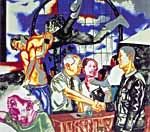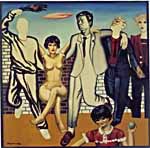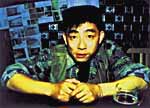|
It's not easy to describe Wang Jinsong's art. In one
of his oil paintings, blank, faceless figures pose next
to people in business suits and ties - a disquieting
contrast of Chinese and Western aesthetics, of traditional
minimalism and modern realism.
In another piece, psychedelic
acrylics spread across the canvas, glistening like sunlight
off grease. The combination of pigments - bleeding purple
splashed on stark black - bear little resemblance to
reality.
And finally, there's
neither trace of ink nor brushstroke in his work Chai.
Instead, Wang uses a camera to capture a reality the
brush can't in a set of 100 photographs of the Chinese
character for demolish (chai) that were scrawled on
walls destined for destruction as Beijing undergoes
urban renewal.
But which style best
represents Wang, a man whose youthful appearance belies
his age of 36, and whose black hair hangs down in a
flap past his shoulders and whose chin shows the early
shadow of a goatee? What style best cuts to the soul
of a teacher with over 20 years experience, a gentleman
with a calm voice and easygoing demeanor?
"All of my works are
me," says Wang. "Each one represents my thoughts and
ideas. I wouldn't make them public if they didn't."
As a result, the history
of Wang Jinsong and his art is one of evolution. As
times have changed, so has his style. However, his ultimate
message has stayed true to his underlying vision.
"My line of thought
is continuous - it has never ended or changed," says
Wang. "Yes, I have used different styles because I like
to be free and creative, but I am also concerned with
human beings and human nature at work in everyday life.
I want people to stop and think about these things."
Wang's rich life experiences
are the source of his artistic inspiration. Born in
the northeast province of Heilongjiang in 1963, Wang
escaped the frozen north in 1983 to attend the Zhejiang
Academy of Fine Arts in Hangzhou. There, he majored
in traditional Chinese painting. After graduating in
1987, he landed a job as a professor at the Beijing
College of Education, where he continues to teach. These
days he spends most of his spare time in his apartment/studio
in the university district of Beijing.
Wang first gained international
attention in 1993 when his work was featured in the
Post-1989: China's New Art exhibition in Hong Kong.
The collection toured internationally and showcased
the brightest new stars of Chinese contemporary art,
sparking an interest in a style entirely new to the
West.

"Too many people think
of traditional Chinese paintings or calligraphy when
they think about Chinese art," says Angela Goding, assistant
director of Beijing's Courtyard Art Gallery. "People
like Wang and exhibits like Post-1989 really made a
splash and opened people's eyes to new trends in Chinese
art."
A list of exhibitions
featuring Wang's works reads like a world atlas. Most
recently, Wang's photo collection Parents was on display
at the National Museum of History in Beijing, part of
the Aperture Foundation-sponsored retrospective China:
Fifty Years Inside the People's Republic. The show is
now on exhibit at the Shanghai Art Gallery through the
end of February.
But long before Wang
was recognized as an influential artist, he knew that
expressing his thoughts on the world through art was
what he wanted to do with his life. Beginning right
after high school, he travelled extensively across China's
countryside, amassing a wealth of images and experience.
Later, travel to the United States and Europe further
refined his aesthetic perspective. But how and what
Wang wanted to express proved counter-intuitive to what
he had learned in school.
"I betrayed my training,"
says Wang with an embarrassed laugh. "I found that traditional
painting couldn't express what I experienced in everyday
life."
In the early 1990s,
Wang turned to oil painting, but still retained many
aspects of Chinese painting, including minimalist strokes
and negative space. He would change direction again
in 1998 to embrace vivid acrylic colors and surrealism.

"I wanted to establish
a new style," says Wang. "But on a deeper level, the
colors emphasize thoughts and attract attention while
creating a world that is almost real but at the same
time so much different than the one we see with our
own eyes."
In many ways this phase
of Wang's art, with its liquid-crystal visual effect
and its contrast to his earlier oil paintings, was the
most critical and satirical. The detailed faces, as
opposed to the blank ones in Wang's earlier work, were
intended to reflect how modern society's superficiality
is masked by pride and pomposity.
Now Wang devotes almost
all his time to photography. Whether he's taking color
pictures of families or Chinese characters chalked onto
walls, Wang captures them with the same attention to
detail he uses in his paintings.
"I have not stopped
painting, but using the camera gives you a different
viewpoint," says Wang. "It is more direct. This is reality
and it leaves no doubt about what you're seeing."
Many art critics and
informed observers have praised Wang for his ability
to observe and record everyday life using a variety
of media.
Karen Smith, a Beijing-based
art consultant, says in her seminal essay on the Post-89
movement: "Wang depicts such issues as the cannibalistic
nature of social feeding, more politely termed 'dining
out,' accidents made social spectacle, incident as entertainment,
It appears on his canvas - just as it does in the city
- as a composite of old and new; good and bad; fine
and fallacious; crude and cultured, all stewing in the
same stock."
Standard Family, a set
of 200 photographs of the new nuclear Chinese family
- mother, father and one child - is an example of how
Wang uses his art to convey a personal, social statement.
On one hand it evokes the joy of tighter family units
and increased prosperity resulting from China's one-child
policy. On the other, it forces one to think about a
society without siblings.
The provocative photo
collection has appeared in exhibits in Japan, Germany
and Switzerland.
"The works I've felt
most proud of are the ones produced when I've just started
using a new medium," Wang reflects. "With photography,
I feel like I've found the perfect form to express my
thoughts and that I can just keep going deeper and deeper.
At the same time, I'm always searching for new ways
to express myself. I'm not afraid to try them out."
Wang Jinsong's photo
series "Parents" can be seen in the Aperture Foundation-sponsored
retrospective "China: Fifty Years Inside the People's
Republic." The show is now on exhibit at the Shanghai
Art Gallery through the end of February.
|





